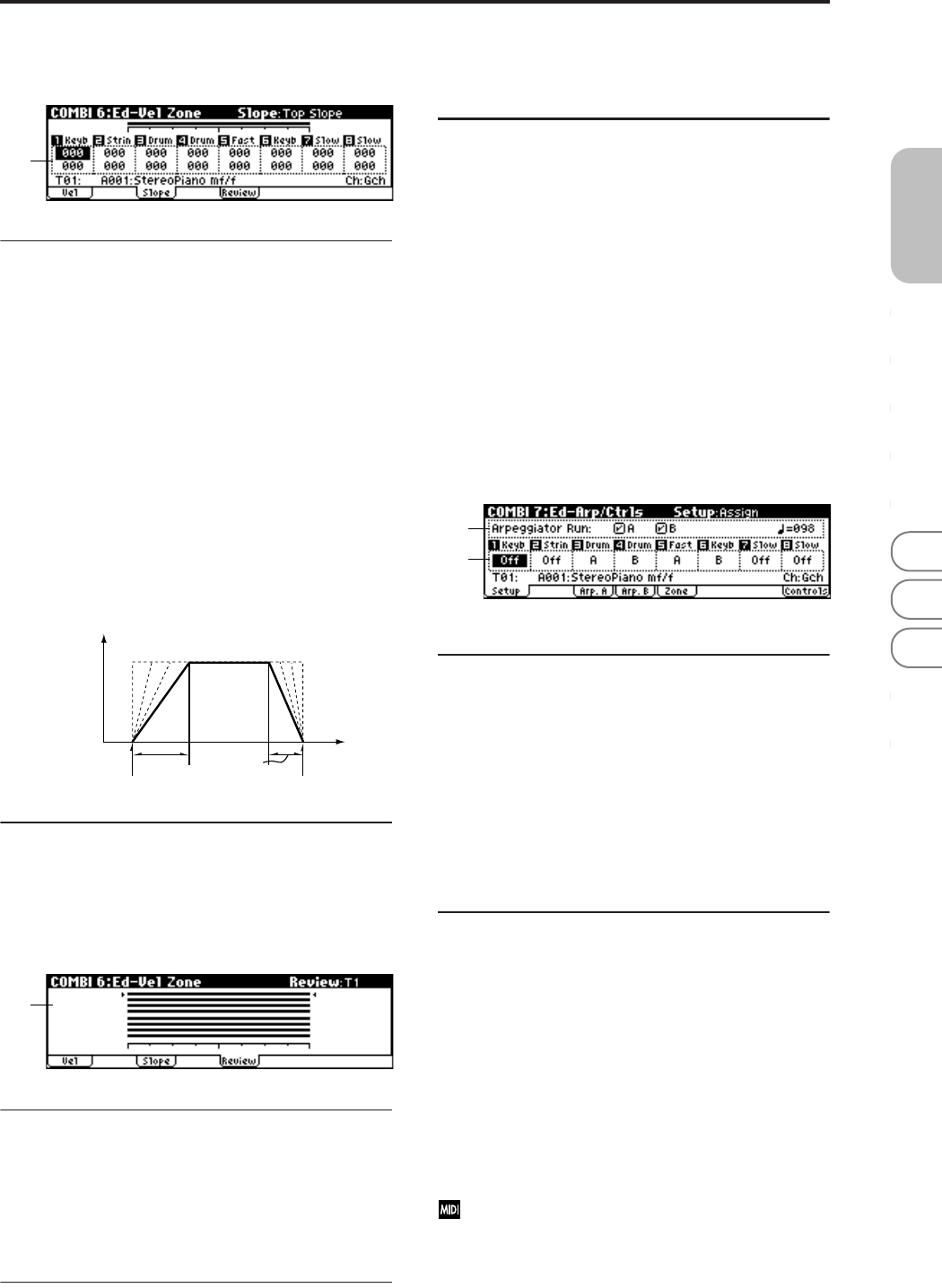
47
COMBI
0
123456789
6–2: Slope (Velocity Slope)
6–2a: Top Slope, Bottom Slope
Top Slope [000…120]
Specifies the number of velocity steps over which the origi-
nal volume will be reached, starting from the Top Velocity.
0: The volume will be at the original value from the top
velocity.
120: The volume will decrease as the velocity approaches the
top velocity.
Bottom Slope [000…120]
Specifies the number of velocity steps over which the origi-
nal volume will be reached, starting from the Bottom Veloc-
ity.
0: The volume will be at the original value from the bottom
velocity.
120: The volume will decrease as the velocity approaches the
bottom velocity.
How volume will change according to key velocity
■ 6–2: UTILITY
☞“Write Combination,” “Solo Selected Timbre” (0–1)
6–3: Review
6–3a: Velocity Zone Map (All)
T1...T8
Displays the range of velocities that each timbre will
respond to.
The range of velocities sounded is shown as a line, and the
slope portion is shaded.
■ 6–3: UTILITY
☞“Write Combination,” “Solo Selected Timbre” (0–1)
COMBI 7: Ed–Arp/Ctrls
(Arpeggiator/Controls)
These parameters specify how the arpeggiator will function
within the combination. Two arpeggiators can run simulta-
neously.
X50: The B-mode functions of REALTIME CONTROLS [1]–
[4] knobs, and the functions of assignable switches [SW1]
and [SW2].
microX: The B-mode functions of REALTIME CONTROLS
[1]–[4] knobs.
This offers a variety of possibilities, such as applying sepa-
rate arpeggio patterns to two sounds that have been
assigned as a keyboard split, or using velocity to switch
between two arpeggio patterns.
7–1: Setup
7–1a: Arpeggiator Run, (Tempo)
Arpeggiator Run A, B (Run A, B) [Off, On]
When the [ARP ON/OFF] button is on, the arpeggiator(s)
checked here will run if they are assigned to a timbre by
“Assign” (7–1b). (☞0–4(5)a)
(Tempo) [040...240, EXT]
Set the tempo of the arpeggiator. This can also be adjusted
by the REALTIME CONTROLS C-mode [TEMPO] knob.
☞p.34 “ (Tempo)” (0–1a)
7–1b: Assign
Assign [Off, A, B]
Assigns arpeggiator A or B to each timbre 1–8. When the
[ARP ON/OFF] button is on, the arpeggiator specified for
each timbre will operate according to “Arpeggiator Run”
and these settings.
Off: The arpeggiator will not play this timbre.
A: This timbre will be played by Arpeggiator A. Make set-
tings in the Arp. A page to select the arpeggio pattern and
set parameters.
B: This timbre will be played by Arpeggiator B. Make set-
tings in the Arp. B page to select the arpeggio pattern and
set parameters.
If the “Status” (2–1a) of the timbre is INT, each timbre
1–8 to which arpeggiator A or B is assigned will be
sounded by the note data generated by the arpeggiator,
regardless of the “MIDI Channel” (2–1a) setting of the
timbre. If a timbre is set to EXT or EX2, MIDI note data
will be transmitted on the “MIDI Channel” of each tim-
bre.
6–2a
Bottom Slope
Top Slope
Bottom Velocity Top Velocity
Velocity
Volume
6–3a
7–1a
7–1b


















